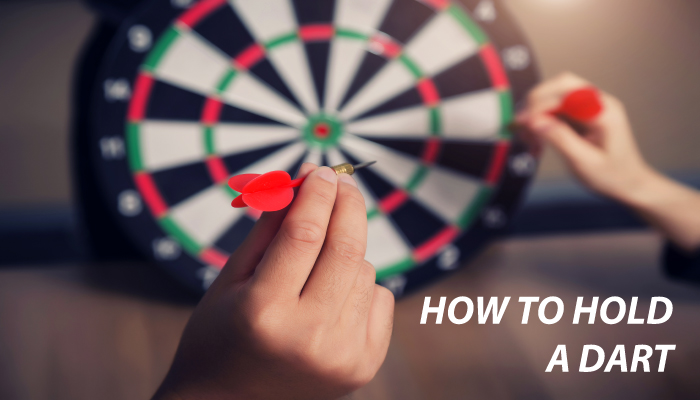The way you hold a dart plays a significant role in the accuracy of your dart throw and overall performance. Sadly, it’s also something that many people overlook.
Whether you’re a beginner or an experienced player, having the right grip for holding and aiming the dart can make all the difference in how accurately you release and aim it.
A proper dart grip can greatly enhance your throwing accuracy, giving you the edge you need to perform at your best. It’s important to find a grip that works for you, and to make sure that you hold the dart consistently every time you throw.
Importance of Proper Dart Grip
Choosing a proper way to hold a dart helps to provide stability and control needed for a good throwing motion. It aids you in controlling the direction, release point and speed of darts.
This lessens the chances of a wild or stray throw and offer better accuracy. Additionally, correcting the finger positions on the grip also aids in putting the right amount of pressure on the grip. It reduces muscle fatigue and strain.
How to Hold a Dart?
There are various types of grips that players can use when throwing darts. But the steps to hold a dart are quite similar whether you use 2-finger, 3-finger, 4-finger or 5-finger grip.
There are just 4 key steps.
- The first step is to find the dart’s center of gravity. Then, put your thumb a bit behind the dart’s center of gravity.
- Place your index right above that.
- If you are using more fingers, place them comfortably on the barrel beside the index finger.
- Don’t make fist with the free fingers. Keep them open and relaxed.
As for how many fingers to use for holding a dart, it depends on the comfort and skill level of a player. The most common one is the 3 finger dart grip. It provides moderate control and ease of coordination.
Though the best grip might vary from person to person regardless of skill level, 3-finger grip works for most players. It’s a suitable grip for beginners to start playing darts with.
Other grips like the 4-finger or 5-finger grip might work for you if you are good at releasing the dart from all fingers at once from the right point.
In comparison, 2-finger grip is for those who are good with controlling the dart. However, these are mostly difficult for beginners to have an accurate throw with.
| Preview | 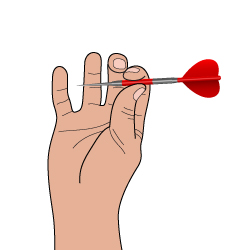 | 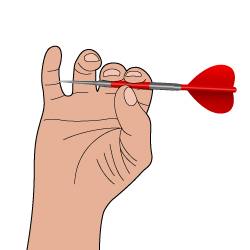 | 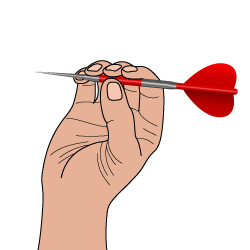 | 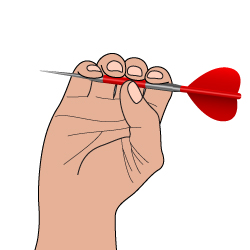 |
| Grip name | 2-finger dart grip | 3-finger dart grip | 4-finger dart grip | 5-finger dart grip |
| Fingers used in this grip | Thumb and index | Thumb, index, and middle finger | Thumb, index, middle, and ring finger | All fingers |
| Best time to use | Easiest release | Moderate Control | More control that 3-finger grip and easier release than 5 finger grip | Maximum control |
| Best for whom? | Mostly for experienced players | Recommended by most players. Great for beginners. | Intermediate and experienced players | Experienced players |
How do Professionals Hold a Dart?
There isn’t any specific grip that professionals use. They have their own unique way of holding the dart and use different grips at different times. It is typically personal to the player and may have been developed through trial and error, or it may have been influenced by other players or their own preferences.
For example, Phil Taylor uses pencil grip. He holds the dart like a pencil, keeping the dart pointed forward. In comparison, Eric Bristow was seen using small finger-tip grip many times. It’s where the pinkie finger stays wide away from others and touches the dart’s tip.
Sometimes the dart preference influences the grip type as well; like dart legend John Lowe was naturally more likely to use the 3-finger dart grip because of his short dart preference. While sometimes players even prefer not to hold behind the center of gravity. For instance, another legend of the game, Bob Anderson holds the dart slightly behind the tip, located way before the darts’ center of gravity.
Things to Consider for Holding the Dart Better
1. Choose the right dart (especially the barrel)
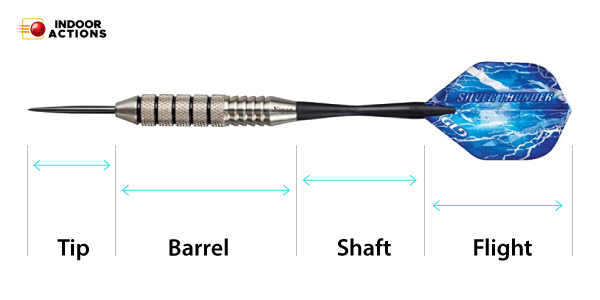
It’s essential to know about all the parts of a dart for choosing the right one for your grip. Among the main 4 parts of a dart, the barrel is the part that is most likely to be different depending on the way you hold the dart. Let’s get to know all the parts and how different barrels can affect the grip.
Tip
It’s the pointy part of the dart that sticks with the dartboard when you throw it. When selecting a tip, consider the type of dartboard you’ll be playing on, taking into account the distinction between steel tip vs soft tip darts.
For instance, electronic dartboards are only compatible with soft-tip darts, while steel tip darts are designed for traditional bristle dartboards.
Barrel
Consider the weight distribution of the barrel, as well as its length. A longer barrel and shaft provide more space for fingers. This makes it easier to hold the dart. On the other hand, a shorter barrel and shaft require a tighter grip, making it more challenging to hold the dart.
A longer barrel is better suited for a 4 or 5-finger grip. And as for the barrel’s weight distribution, it helps you to know where the center of gravity is. Your finger placement for grips differs depending on this very center of gravity.
Shaft
It’s the thin rod-type part that connects the barrel and flight. The shaft should be strong enough to support the weight of the dart but also light enough not to affect the balance.
Flight
It’s the tail of the dart. The flight should be sturdy and not easily damaged but also lightweight to minimize drag.
2. Hold a bit behind the darts’ center of gravity
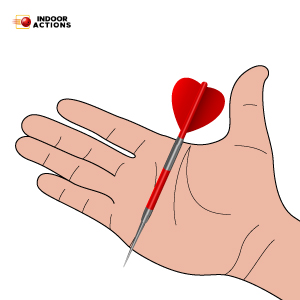
The point at which the weight of the dart is evenly distributed is the center of gravity of a dart. Holding the dart at this point allows for greater control and balance. This will result in a more consistent throw and improved accuracy.
How to find the center of gravity of a dart?
- Start with Positioning: Place the dart on the palm of your dominant hand, the one you’ll use to throw.
- Move Towards the Tips: Gradually slide the dart towards your fingertips.
- Identify the Balance Point: The exact spot where the dart feels balanced on both sides is its center of gravity.
It is important to note that darts have different centers of gravity mainly because of different barrel types. It can be front-weighted, back-weighted, or even weighted. So, it is crucial to experiment with different darts to find the one that you are most comfortable with. Holding the dart a bit behind the center of gravity works for most players.
3. Strong vs. weak grip: Find a fine line in between
When holding the dart, it’s crucial to have a relaxed grip. A strong grip can cause tension in your hand that makes it harder to release the dart and may cause your hand to shake and miss the aim.
Additionally, it puts unnecessary strains on your muscles. That can lead to inconsistent throws and decreased accuracy. On the other hand, a weak grip can cause the dart to slip out of your hand, making it difficult to control the dart’s trajectory and achieve a successful throw.
Try to find a balance between them. The key to a relaxed grip is to hold the dart lightly, but with enough force to keep it secure in your hand. Start by holding the dart around its center of gravity. Then, gently adjust your grip until you feel comfortable and in control.
4. Keep the free finger open
The term “free finger” refers to the finger you are not using to hold the dart. Many might close the fingers while holding the dart. But doing so creates more tension and impacts the game negatively.
When the free finger is open, you can control the dart in a more natural way. The dart can be released with a smoother motion. It makes the throws more consistent and accurate.
5. Keep the dart tip upward
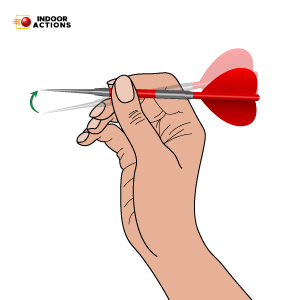
Keeping the tip straight to the target eventually makes the dart go below it. When the tip of the dart is pointing upward, it helps to maintain the flight path needed to hit the target.
That aids in ensuring to hit the board straight on, rather than at an angle, which can cause the dart to bounce off or miss the target entirely.
Frequently Asked Questions
Is there a wrong way to hold a dart?
There’s no one right or wrong way to hold a dart, as everyone has different preferences. You might use a different number of fingers to hold the dart despite the skill level. However, 3-finger dart grip is more suitable for most players, especially for beginners because of its moderate control and ease of release.
While the 2-finger, 4-finger and 5-finger dart grip is suited for skilled players. Additionally, holding the dart a bit behind the center of gravity, keeping the free fingers open, and the dart tip upward is beneficial in most cases.
How hard should you grip a dart?
You should grip the dart firmly enough to maintain control, but not so tightly that it causes tension and inconsistent throws. A relaxed grip will allow for a smoother throw and better aim.
Conclusion
It is essential to remember that everyone’s hand and preference are unique, so the grip that works best for you might not match most other players. Try out different grips and take note of how each one feels. Consider the comfort, control, and consistency that each grip provides.
It may take some time. It’s important to be persistent in your search for the best way of holding a dart. Once you have found the best one for you, continue practicing till it becomes second nature. Then, grab your darts and hit the bullseye!
You might also like:
